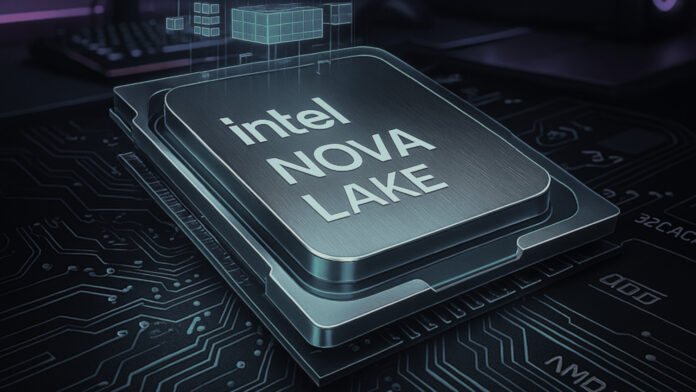Intel may be preparing a major shift in its CPU strategy with the upcoming Nova Lake processors, which are expected to be released in 2026. According to recent leaks, these chips may feature a significant cache upgrade aimed at enhancing gaming performance, similar to AMD’s successful 3D V-Cache technology.
Table of Contents
Intel Eyes AMD’s Playbook with Big Cache for Gamers
Rumors suggest Intel plans to introduce a new cache design called Big Last-Level Cache (bLLC). This move mirrors AMD’s 3D V-Cache, which powers top-performing gaming CPUs, such as the Ryzen 7 7800X3D and 9800X3D.
The goal? Deliver faster, more responsive gaming experiences by stacking on more cache memory.
What We Know So Far About Nova Lake
Leaked details from X (formerly Twitter), highlighted by VideoCardz, point to two main Nova Lake desktop chips:
- Flagship model: 16 performance cores and 32 efficiency cores. Surprisingly, this version may not include the new bLLC.
- Gaming-focused model: 8 performance cores and 16 efficiency cores, with bLLC onboard for enhanced gaming performance.
Another leak from data miner Haze mentions a second 8-core variant. This one may include:
- 12 efficiency cores
- 4 low-power “tiny” cores
- The same bLLC cache
- A 125W power draw
Both 8-core models are expected to feature this new cache design, making them prime candidates for gamers.
Intel’s Cache May Outpace AMD’s
VideoCardz reports that Intel could equip Nova Lake chips with up to 144MB of L3 cache. That’s more than AMD’s current top-tier Ryzen 9950X3D, which maxes out at 128MB.
If true, this would mark a significant leap in cache capacity, potentially giving Intel an edge in gaming workloads.
When Will Nova Lake Launch?
Intel hasn’t confirmed the release timeline, but rumors suggest a late 2026 launch. However, there’s still uncertainty about what comes next in Intel’s roadmap.
Some sources hint at an Arrow Lake Refresh arriving before Nova Lake. This refresh could launch as the Core 300 series, while Nova Lake might debut as the Core 400 series for both desktops and laptops.
A Strategic Pivot to Win Back Gamers?
Intel appears to be targeting two key audiences:
- Power users: The flagship Nova Lake chip with 16 performance cores aims to handle everything from gaming to heavy multitasking.
- Gamers: The 8-core bLLC-equipped chips are designed to deliver top-tier gaming performance at a more accessible price.
This strategy mirrors AMD’s approach. While AMD offers X3D chips with 12 or 16 cores, the 8-core 7800X3D remains the go-to for most gamers due to its price-to-performance ratio.
Can Intel Regain Gamer Trust?
Intel’s recent track record with gamers hasn’t been stellar. The Arrow Lake lineup underwhelmed in gaming benchmarks, even after multiple patches. Stability issues from previous generations also linger in the minds of many PC enthusiasts.
Online sentiment shows skepticism. Forums and communities reflect a loss of trust in Intel’s ability to deliver reliable, high-performance gaming CPUs.
Still, this new direction with Nova Lake could be Intel’s shot at redemption. By focusing on cache-heavy designs and gamer-friendly pricing, Intel might just win back its core audience.
If these leaks hold, Nova Lake could mark a turning point for Intel. With a bold new cache strategy and gamer-focused chips, 2026 might be the year Intel reclaims its place in the gaming CPU race.

